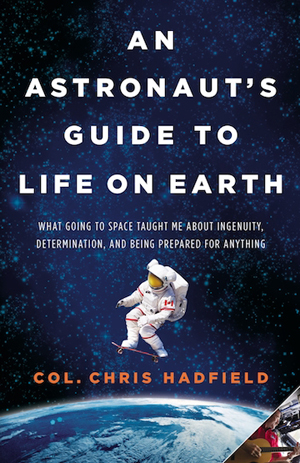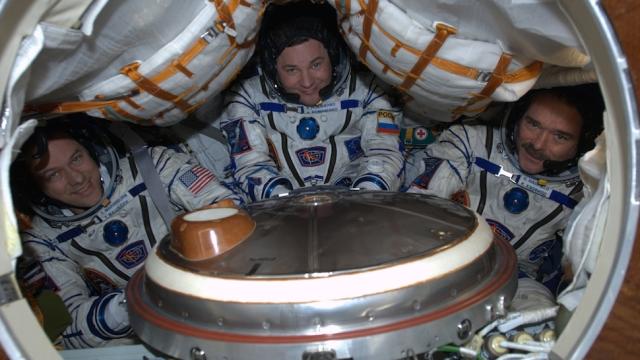The rumble of power just got stronger and more insistent as we heard the countdown in Russian through our headsets and then, “Pusk.” Liftoff. It was a very different sensation than my two Shuttle launches, much more gradual and linear as the vehicle burned off enough fuel to lighten for liftoff. The initial acceleration didn’t feel all that different from just sitting on the ground. We knew we were leaving the pad more because of the clock than the sensation of speed.
This post has been excerpted from An Astronaut’s Guide to Life On Earth: What Going to Space Taught Me About Ingenuity, Determination, and Being Prepared for Anything, by Col. Chris Hadfield, available now on Amazon.
From the viewpoint of those watching in the stands, those first 10 seconds of the launch were agonisingly slow. Kristin later admitted she’d been terrified, so much so that she hadn’t wanted to take any photos or take her eyes off the Soyuz for a second. Compared to a Shuttle launch, the rocket ship seemed to hover above the pad just a little too long. One guest likened it to the ultimate bench press, saying it looked as though an unseen weight lifter was standing underneath, straining mightily to push the vehicle off the ground, but failure was always an option.
Inside the vehicle, however, we were full of anticipation, not dread: ready for this machine to do its work. It was like being a passenger in a big locomotive, but one who can throw the emergency hand brake if necessary. We had some degree of control. The challenge was knowing if and when to assert it. Within a minute, we were pushed down in our seats more and more heavily. Initial ascent felt purposeful but smooth, a little like being on a broomstick that an invisible hand was calmly steering a bit to the left, then a bit to the right, back and forth. The rocket ship was self-correcting its attitude as we ascended and the wind and jet stream changed.
The ride got less smooth as it went on, though. As our first-stage engines cut off and the boosters exploded off the side, there was a noticeable change in vibration and a decrease in acceleration — not speed, that was always increasing. We were thrown forward and then steadily pushed back again as the Soyuz, lightened, roared upward. This tail-off, lurch-forward motion was repeated when the second-stage engines separated, and as the third-stage engines lit, the ones that would take us to orbital speed, we were slammed back even more definitively. But that was a very good thing to feel, because a year before, the third stage hadn’t lit on an unmanned Progress resupply vehicle and it had crashed in a sparsely populated region of the Himalayas. If that happened to us and the Soyuz parachutes deployed, it would be days before anyone found us. We’d all done winter survival training in remote areas to be prepared for just such a scenario, so we had a good idea just how miserable those days would be.

The whole way up, we breathed a little easier as each important milestone passed. But it was not a nerve-wracking process. Approaching certain thresholds we knew it was possible that something really bad might happen, but we also had a plan for what each of us would do. We were wide awake and ready to take action. If anything went drastically wrong, like the engines didn’t cut off on time, I would throw a switch and press two emergency buttons to fire the explosive bolts that would blast our capsule away from the rocket. I would have five seconds to assess what had gone wrong and take the appropriate actions. The three of us had gone over who was going to do what, with whose permission, again and again. We had agreement that if X didn’t happen within Y seconds, I was going to activate contact separation. The left-seater is the only person who can even reach those buttons. I had raised the lids that normally cover them so I was ready to press at any moment, and it was a wonderful moment when I could close those lids.
Nine minutes had passed. Our third-stage engines had cut off, the Soyuz had separated, and its antennae and solar panels had deployed. Flight control was about to switch from Baikonur to the Russian Mission Control Center in Korolev, a suburb of Moscow.
Every crew brings its own small, tethered “g meter,” a toy or figurine we hang in front of us so we know when we are weightless. Ours was Klyopa, a small knitted doll based on a character in a Russian children’s television program, courtesy of Anastasia, Roman’s 9-year-old daughter. When the string that was holding her suddenly slackened and she began to drift upward, I had a feeling I’d never felt before in space: I’d come home.
Excerpted with permission from An Astronaut’s Guide to Life on Earth: What Going to Space Taught Me About Ingenuity, Determination, and Being Prepared for Anything by Chris Hadfield. Published by Little, Brown and Company. (c) 2013 by Chris Hadfield
Top image from right to left: Thomas Marshburn, Roman Romanenko, and Chris Hadfield in the Soyuz spaceship. Image by NASA.
